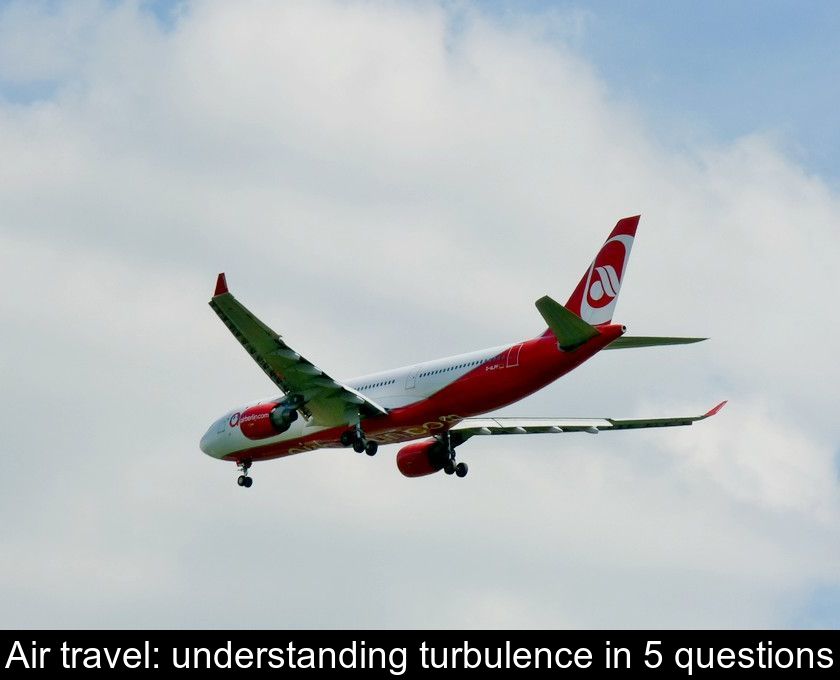Air Travel: Understanding Turbulence In 5 Questions
On May 26, 2024, twelve passengers were injured on a Qatar Airways flight due to severe turbulence. This incident occurred five days after the death of a British passenger on a Singapore Airlines flight, where more than one hundred people were injured following extreme turbulence. As this phenomenon makes headlines, we offer you a better understanding of what it entails in 5 questions.
1- What is turbulence?
It is quite common during a plane trip for the aircraft to enter turbulence zones. This phenomenon, well known to meteorologists and pilots, crystallizes the fears of passengers, whether they are phobic of flying or not. But few of them know precisely what turbulence is.
Atmospheric turbulence can be defined as air currents that affect the atmosphere. Just like water, air is a fluid traversed by currents.
When a plane encounters ascending or descending air currents on its trajectory, it can experience jolts or suddenly lose altitude in an air pocket. This is why the crew asks passengers to fasten their seatbelts when the plane enters a turbulence zone.
2- What are the causes of turbulence?
This phenomenon that affects flight stability is well known to meteorologists.
Atmospheric turbulence can have different causes:
• It can be caused by thunderstorms.
• It can be related to air movements around mountains or orographic waves.
• It can be caused by cold or warm air fronts.
• It can be linked to jet streams, bands of strong winds that circulate around the Earth.
Meteorologists have tools to predict these atmospheric phenomena. But, as you have surely already noticed, weather forecasts are not infallible. That is why pilots and passengers can encounter unexpected jolts during a flight.
Thanks to radars, pilots can anticipate and avoid turbulence related to thunderstorm clouds, cumulonimbus. However, clear-air turbulence is harder to avoid. These sudden disturbances in the atmosphere occur in cloudless areas and cause violent shaking of the aircraft.
They are generally due to the phenomenon of wind shear near jet streams. This type of turbulence is particularly dangerous and problematic because pilots have no visual cues to anticipate them.
3- Does climate change increase turbulence?
Unfortunately for people who are generally afraid of flying and particularly of turbulence, this phenomenon is likely to become more frequent if the climate continues to warm.
Due to climate change, specialists expect a doubling or even tripling of severe turbulence in the jet streams in the coming decades. Scientists have observed that “clear-air” turbulence has increased by 55% in the North Atlantic since 1979.
The explanation for this increase is simple: global warming increases the temperature difference between the cold poles and the hot tropics. This results in more wind shear, which means sudden changes in wind speed and/or direction in the jet streams.
4- What are the dangers of turbulence on an airplane?
First of all, it should be noted that atmospheric turbulence cannot cause a crash. Modern airplanes are designed to withstand much stronger jolts, up to 150% of the strongest possible turbulence. Therefore, even though this experience is unpleasant, you do not need to fear crashing when the plane passes through a turbulence zone.
However, according to a 2021 report from the U.S. National Transportation Safety Board, atmospheric turbulence remains “a significant cause of accidents and injuries” during air travel.
As the plane can suddenly drop several meters, the main risk for passengers is being thrown around the cabin or being injured by a projectile. Indeed, during severe turbulence, luggage and objects can start flying through the cabin.
Fortunately, deaths related to this phenomenon on commercial flights are very rare. The death of a passenger on the Singapore Airlines flight from London to Singapore on May 21, 2024, was caused by a heart attack. It should also be noted that there had been no deaths related to turbulence on a commercial flight since 2009.
To minimize the risk of injury, the best preventive measure is to remain seated and buckled up as much as possible during the flight. In case of unexpected jolts, you are safe if you have your seatbelt fastened.
5- Which seat to choose to feel less turbulence?
The jolts caused by atmospheric turbulence can be felt more intensely inside the aircraft than they actually are outside.
If you have a phobia of this phenomenon, know that you can improve your comfort during a flight by wisely choosing your seat when booking or checking in.
According to aeronautics experts, turbulence is less severe when seated near the wings and emergency exits of the plane. On the other hand, the jolts are felt more strongly by passengers seated near the tail of the aircraft.











